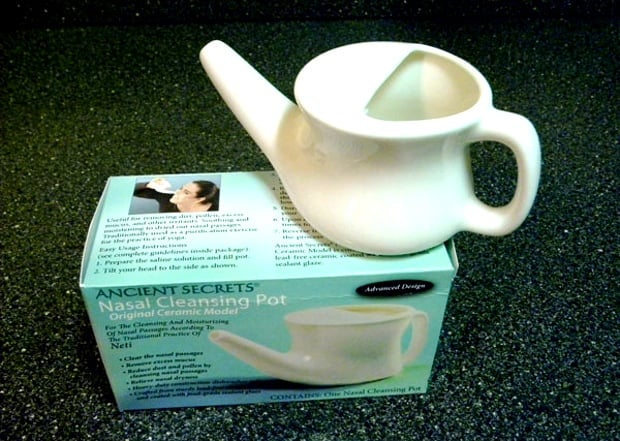Messy. Messy, and interesting–those were the first words that came to mind after trying a neti pot for the first time. But more on that in a moment.
Although nasal irrigation is a centuries-old custom and saline is a well-known sterilization method, the neti pot is enjoying a curious revival of late. According to the brochure enclosed with the model I bought, this ancient nasal cleansing method is one of six purification practices used to prepare the body for yogic practices. In recent years, it’s seen a resurgence among Western cultures for its ability to clear pollen and other airborne irritants that send us into a day-disrupting allergic fit.
“I’ve been in practice for more than 20 years, and back when we were in residency we trained and instructed people to do salt-water irrigations, so to me, it’s how things have always been,” says otolaryngologist Eric J. Furst. “But people are definitely coming in and asking about it more.”
There are lots of nasal irrigation devices, from neti pots to squeeze bottles to nasal pumps and bulb syringes–and they’re all comparably effective. Most of the neti pots you’ll find in pharmacies or health and wellness stores are ceramic or plastic and resemble small, elongated teapots or dainty watering cans. Mine, pictured above, is obviously the latter–and my experience with this little device certainly made an impression.
I mixed the enclosed salt packet with eight ounces of lukewarm water, as directed (you can make a saline solution using a teaspoon of non-iodized table salt–not sea salt, which can irritate). With my left ear tilted to my shoulder, I inserted the spout into my right nostril, took a breath through my open mouth, and tipped the pot–way too much.
The first split second felt like drowning. The sensation is akin to getting water up your nose when swimming, but without the sting. Saline surged out of my left nostril, spilling down my face and all over my shirt instead of pleasantly exiting as shown in this video.
Gross.
But getting the hang of it–and remembering to keep breathing through my mouth–only took a few moments. Irrigating my left nostril went much more smoothly, and the saline–clear of any debris–streamed out as intended.
The surprise didn’t come until the recommended nose-blowing afterward, however, when I saw how much flotsam and jetsam my nasal cavity could harbor. Again, nasty, but totally worth it; the first inhalation felt like crisp autumn breeze instead of stuffy bathroom air. An hour afterward, it felt the same.
“If someone is just sneezing all day and feeling miserable, especially at this time of year when the pollen counts are high, it just makes good sense to wash your nose,” says Furst. “It’s not just the exposure, but also the amount of time the pollen is sitting in your airways. So if people wash their nose, they can get rid of a lot of what’s stimulating the response.”
According to the American Academy of Otolaryngology, nasal irrigation reduces inflammation, fights infections, and increases drainage. In essence, all of your allergy and sinus woes–except itchy eyes, of course–can be addressed with a quick rinse. Furst, who runs a private practice in Springfield, sees lots of patients who use neti pots, and compares washing your nose to brushing your teeth–it’s just good hygiene. Some of his patients with allergy and sinus concerns even use rinses as their sole treatment.
Furst says, “The worse your symptoms, the more I’d urge you to try [irrigating], maybe once or twice a day, along with an antihistamine. There’s really no downside.”
The benefits also extend beyond allergy and sinus relief. All of Furst’s patients who undergo surgery are given a saline system to prevent infection, clear scabs, and speed up the healing process. Saltwater can also soften and moisturize dried-out mucous membranes, which can cause nose bleeds.
“It’s a lot more than just an allergy treatment,” Furst says, adding that the human body is “basically made of saltwater.” His recommended saline recipe is a teaspoon of salt, eight ounces of water, and half a spoon of baking soda to maintain pH balance. And he warns against using your neti pot with plain water: “It would be very uncomfortable and possibly make your symptoms worse.”
At the very worst, using unsanitary water in a neti pot can potentially lead to death. Last year two people died from brain-eating amoebas after using tap water.
Still, apart from the very rare and scary downsides, it’s clear to me why the neti pot is an allergy sufferer’s savior. I don’t have severe allergy problems–my sneezy, miserable days only blow in once in a while–but it’s safe to say on those days, the neti pot will definitely be part of my arsenal.


















